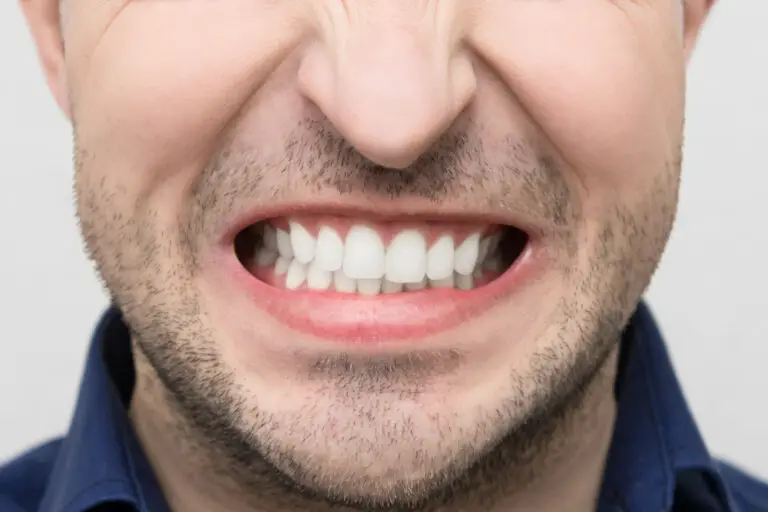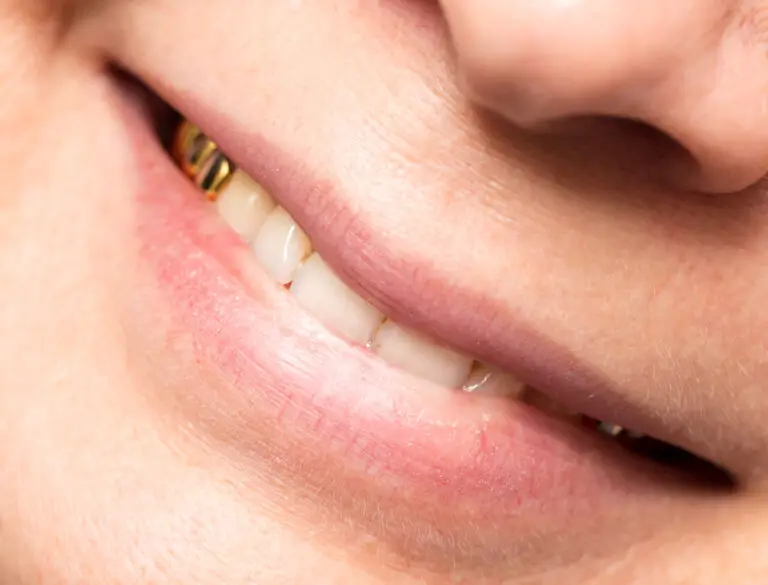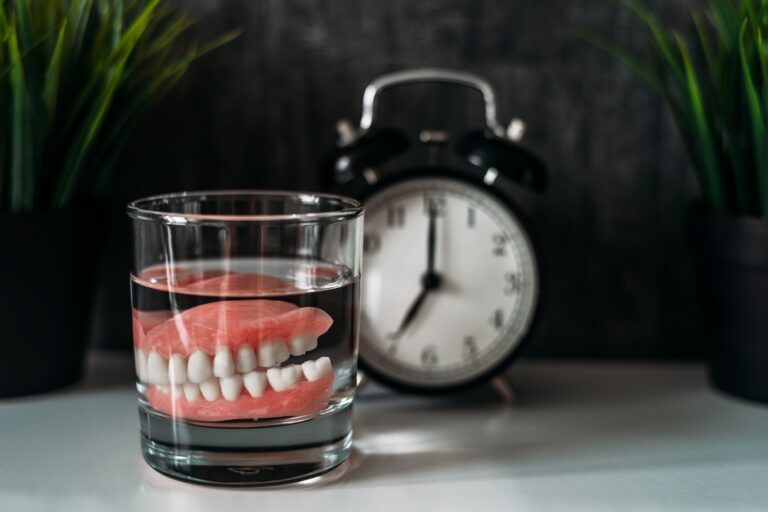It’s very common to experience pain or discomfort in your two front teeth when biting down or chewing. The medical term for this condition is dentinal hypersensitivity. It occurs when the dentin, the bony tissue just under the enamel of the teeth, becomes exposed and unprotected. This exposes microscopic tubules in the dentin that lead directly to the nerve of the tooth, making it extremely sensitive to hot, cold, acidic or sugary foods and liquids.
While dentinal hypersensitivity can occur in any tooth, it most frequently affects the front incisors and canine teeth. There are several potential causes for the localized pain and sensitivity in these front teeth. Properly identifying the underlying reason is crucial for finding the appropriate treatment and relief.
Possible Causes

Here are some of the most common reasons why the two front teeth hurt with biting pressure:
1. Eroded Enamel
The enamel is the tough, outermost protective covering of the tooth. Prolonged contact with acidic foods and acidic drinks can erode and gradually wear away enamel over time. Examples of acidic foods and drinks include citrus fruits, tomatoes, carbonated soft drinks, sports drinks, wine, and even gastric stomach acid that may enter the mouth due to acid reflux disease or recurrent vomiting from illnesses like bulimia.
As more enamel wears down from repeat acid attacks, the softer dentin underneath gets exposed. This allows hot, cold, and biting pressure to reach the sensitive inner structures of the tooth more readily and provoke pain signals. The initial stage of enamel erosion may only be visible under magnification, but will quickly lead to visible surface changes, dents, and transparency of the enamel as it thins. Preventing further acid erosion of the damaged enamel requiresprompt dental attention and dietary changes.
2. Gum Recession
Receding gums are another major cause of front tooth sensitivity. The gums naturally recede to some degree over a lifetime as part of the aging process. However, poor oral hygiene habits that allow plaque buildup along the gumline will hasten recession due to periodontal (gum) disease. Habits like inadequate brushing, smoking, and crooked teeth increase susceptibility to gum disease and recession.
As the gums recede down from their normal position near the crown of the teeth, the sensitive root surfaces become newly exposed. These areas have no enamel protection and are especially vulnerable to pain from hot, cold, and biting pressure. Gum recession initially leads to “long in the tooth” appearance as the teeth look elongated. As more recession occurs, the yellowish root surface becomes visible below the gumline. Root sensitivity continues to increase the further the gums recede.
3. Cracked or Chipped Teeth
Undetected cracks or chips in the front teeth allow irritants to penetrate to the inner dentin and nerve which elicits pain. Cracks often form from trauma, habitual grinding of the teeth at night, or excessive biting forces applied to the front teeth. The upper front teeth are especially prone to cracks and chips due to their position at the front of the mouth.
Cracks can range from tiny hairline fissures inside the tooth to large fractures that split the tooth completely in two visibly. The pain occurs when food particles, air, or liquids enter through the defective outer enamel and reach the exposed dentin underneath. Biting pressure makes the crack surfaces rub together painfully. Unchecked cracks lead to further breakdown, infection of the inner pulp, and eventual tooth loss.
4. Dental Procedures
Certain dental treatments like crowns, tooth bleaching procedures, fillings and orthodontic procedures can lead to temporary sensitivity as the teeth recover. The preparation of teeth during these treatments may remove small amounts of enamel or roughen surfaces enough to make the dentin underneath more vulnerable to pain triggers.
However, this post-procedure sensitivity usually resolves within a few weeks as the tooth surface heals and remineralizes. But if sensitivity persists beyond a month or two, it’s best to return to the dentist to check for issues like inadequate bonding, microleakage around restorations, or abrasion problems with orthodontic appliances.
5. Bruxism
Clenching the jaw muscles during the day and grinding the teeth at night generates excessive biting forces against the teeth. This abnormal parafunctional activity is termed bruxism. People often grind and clench due to high stress levels. The front teeth bear the brunt of these forces which can provoke cracks, accelerate wear, and ultimately cause front tooth sensitivity when biting down. Managing daily stress and wearing a nightguard helps curb bruxism and the damage it inflicts on teeth.
6. Bulimia
The pattern of chronic self-induced vomiting and purging of food seen in patients with bulimia nervosa exposes the back of the front teeth to frequent contact with harsh stomach acids. Repeated acid attacks from gastric juices leaching over the teeth leads to irreversible loss of the protective enamel. This erosion of tooth structure progressively exposes more dentin and provokes chronic dentinal hypersensitivity with normal biting and chewing. Getting appropriate therapy for the bulimia itself is key to stopping this dental erosion.
Diagnosis

If you experience any localized pain or discomfort in your front teeth when chewing or biting down, make an appointment to see your dentist promptly for an exam. They will first evaluate your specific symptoms – when the pain occurs, what provokes it, and which teeth are involved. They will closely visually inspect the front teeth and surrounding gum tissues for any visible signs like cracks, chips, excessive wear, erosion defects, gum recession or plaque buildup. Any chipped restorations will also be looked at.
Your dentist will use a sharp dental explorer instrument to map out any specific areas of sensitivity on the tooth surfaces. They may test sensitivity by puffing air across the teeth and having you drink some cold water to see if any front teeth elicit discomfort. Your dentist will also examine the way your upper and lower teeth fit together to check for abnormal bite alignment problems. Percussion testing, which involves lightly tapping the teeth, can reveal cracks inside a tooth that aren’t visible on the surface.
Dental x-rays are also important to see in-between the teeth for any hidden decay, cracks, root sensitivity or bony damage that cannot be detected just by visual and tactile examination. Your dentist will also thoroughly review your medical history, dental history, and any medications, noting important factors like acid reflux disease, gastric disorders, teeth grinding or jaw clenching issues. Make sure to inform them about any major dietary sources of acid from foods, candies, or beverages as well.
With all the collected information from a thorough clinical and radiographic exam combined with your health history, your dentist can then properly determine the underlying cause and recommend the most effective treatment for relieving your front tooth discomfort when biting.
Treatments
Based on the diagnosed cause, there are several possible approaches available to treat front tooth sensitivity and stop the symptoms:
Oral Hygiene and Dietary Changes
Practicing meticulous daily oral hygiene and limiting intake of acidic foods and drinks can help prevent further enamel erosion in teeth already affected by sensitivity. Using a soft-bristled toothbrush and fluoride containing toothpaste when brushing after meals removes plaque buildup before the acids it produces demineralize enamel. Flossing cleans plaque from interproximal areas that brushing misses.
An antiseptic fluoride mouthwash used regularly helps neutralize lingering acidity in the mouth and remineralize weakened areas. Avoiding frequent snacking limits the frequency of acid attacks on susceptible teeth. Drinking acidic drinks rapidly through a straw pointed towards the back of the mouth can minimize exposure for the front teeth. Quitting smoking improves gum health.
Desensitizing Toothpastes
Special toothpastes containing compounds like stannous fluoride, arginine, strontium salts, or potassium nitrate help block pain transmission and numb nerve activity in the dentinal tubules. Brushing with these toothpastes twice daily for several weeks can gradually reduce sensitivity symptoms. Prescription strength versions are also available from the dentist for more severe cases of dentinal hypersensitivity.
Dental Bonding and Fillings
For localized sensitivity due to cracks, chips, worn areas or exposed root surfaces, applying dental bonding material or tooth-colored fillings can help seal and stabilize the affected area to protect the exposed dentin. This creates a physical barrier that blocks external irritants like air, sugars, acids and cold liquids from penetrating inside the tooth to activate pulpal nerve pain receptors.
Gum Graft Surgery
If gum recession and subsequent root exposure is the primary culprit, periodontal plastic surgery procedures like gum grafting can be done to cover exposed root surfaces. This literally grafts donor gum tissue over denuded roots to protect them and prevent further recession. Along with halting dentinal hypersensitivity, it also yields improved aesthetics as more of the natural tooth is covered.
Orthodontic Treatment
In situations where a poor bite alignment is contributing to abnormal pressures on the front teeth leading to excessive wear, cracks or chips, orthodontic treatment may be recommended. Braces or clear aligners can successfully reposition the teeth for a proper bite that alleviates destructive forces on the front teeth. This also reduces the potential for further damage that provokes recurring sensitivity with chewing and biting.
Nightguards and Mouthguards
Custom made nightguards and mouthguards obtained from the dentist help prevent damage from bruxism and dental trauma that could worsen or provoke front tooth sensitivity. These plastic dental appliances shield teeth from grinding forces and cushion impacts sustained during sports or accidents. This helps minimize the fractures, cracks and enamel loss that contribute to temperature and pressure sensitivity.
Root Canal Therapy
If all other non-invasive measures fail to resolve severe front tooth sensitivity and pulp nerve inflammation develops, a root canal procedure may ultimately be needed. This thoroughly cleans out the inner tooth pulp and seals off the root canals. Removing the inflamed or infected pulp tissue provides complete relief by eliminating the nerve supply to that tooth. But root canals should only be considered as a last resort effort to save a moderately to severely damaged tooth.
Tips for Relief at Home
Until you can have your front tooth sensitivity properly evaluated by a dentist, there are some self-care steps you can take at home to gain temporary relief:
- Use a desensitizing toothpaste daily
- Rinse with an antiseptic fluoride mouthwash to neutralize acid
- Apply fluoride gel with a tray for added enamel protection
- Wear a nightguard if you clench or grind your teeth
- Avoid chewing hard foods like ice, nuts, popcorn kernels and hard candies
- Drink cold or acidic drinks with a straw pointed behind the front teeth
- Have any defective fillings or defective crowns replaced promptly
- Take over-the-counter pain relievers as needed for pain
When to See a Dentist

You should make an appointment to see your dentist promptly if any of the following apply:
- You have severe constant lingering pain in your front teeth
- You notice visible cracks, fractures, chips or injury damaging the front teeth
- There are noticeable areas of redness, swelling or pus discharge from the gums surrounding the front teeth
- Temperature, sweet, or biting sensitivity persists longer than 3-4 weeks despite diligent home care
- Over-the-counter sensitivity toothpastes or medications do not provide any relief
Leaving dentinal hypersensitivity untreated indefinitely allows the processes damaging the teeth to continue unchecked. More enamel erosion, gum recession, cracked tooth structures and dental caries can develop which may eventually require root canals or tooth extractions. It’s imperative to see your dentist right away for accurate diagnosis and immediate treatment when you have front tooth pain with biting or chewing. This offers the best chance of reversing the problem and retaining your natural smile.
Conclusion
In summary, localized pain and discomfort affecting the front teeth when biting down is quite common and usually signals exposed dentinal tubules. A number of issues like eroded enamel, receding gums, cracked teeth and bruxism can provoke sensitivity symptoms. Making an accurate diagnosis requires a comprehensive dental exam and patient history analysis.
Today, many non-invasive treatment options exist to successfully manage dentinal hypersensitivity ranging from desensitizing pastes to dentistry procedures. But catching the problem early and starting treatment quickly produces the best outcomes. Otherwise, the underlying processes can progress leading to escalating damage and tooth loss. Visiting your dentist promptly when you have unexplained front tooth pain allows identification of the source so you can get sensitivity relief and resume normal chewing comfort.
Frequently Asked Questions
Q: Why do my front teeth hurt when I drink something cold?
A: The intense discomfort of front teeth when drinking or eating cold foods is also caused by dentinal hypersensitivity. The wide open dentinal tubules allow external hot and cold temperature changes to irritate the inner nerve endings more readily. A cold drink sends sharp pain signals since the exposed nerve reacts strongly to sudden temperature drops. The cold sensitivity signifies loss of protective enamel and root coverage.
Q: Can front teeth sensitivity be related to sinus problems?
A: It is extremely rare for front tooth pain while chewing or biting to be associated with sinus issues. The nerve roots and tissues surrounding the upper front teeth are not situated close enough to the maxillary sinuses to be affected. Persistent symptoms isolated to the front teeth are most likely dental in origin. Schedule an exam with your dentist first for evaluation rather than assuming a sinus connection.
Q: Is teeth whitening safe if I already have front tooth sensitivity?
A: Teeth whitening treatments, especially higher concentration home bleaching kits, can sometimes exacerbate existing sensitivity temporarily. Discuss options carefully with your dentist first, as lower dose in-office whitening or prescription take-home kits may be safer choices when sensitivity already exists. They can also advise pre-treatment with desensitizing toothpaste for added protection.
Q: What foods should I avoid with sensitive front teeth?
A: It’s best to avoid very hot or very cold foods and drinks that trigger pain. Also, limit consumption of acidic foods like citrus fruits, tomatoes, vinegar, sour candies or yogurt which aggravate enamel erosion. Sticky candies that adhere to teeth surfaces should also be minimized. Hard, crunchy foods like ice, nuts, popcorn kernels and hard crunchy candies can mechanically irritate sensitive areas. Sipping drinks through a straw pointed behind the front teeth prevents contact.
Q: Can I delay treatment for minor front tooth sensitivity?
A: It is not recommended to wait on seeking dental treatment if you notice even minor symptoms of front tooth sensitivity when biting or chewing. The sooner you get a professional assessment, the quicker you can start preventive care or desensitizing therapies to halt progression. Left unchecked, the processes causing the sensitivity can worsen leading to bigger problems. Don’t wait until it becomes severe or you have cracks and decay.






